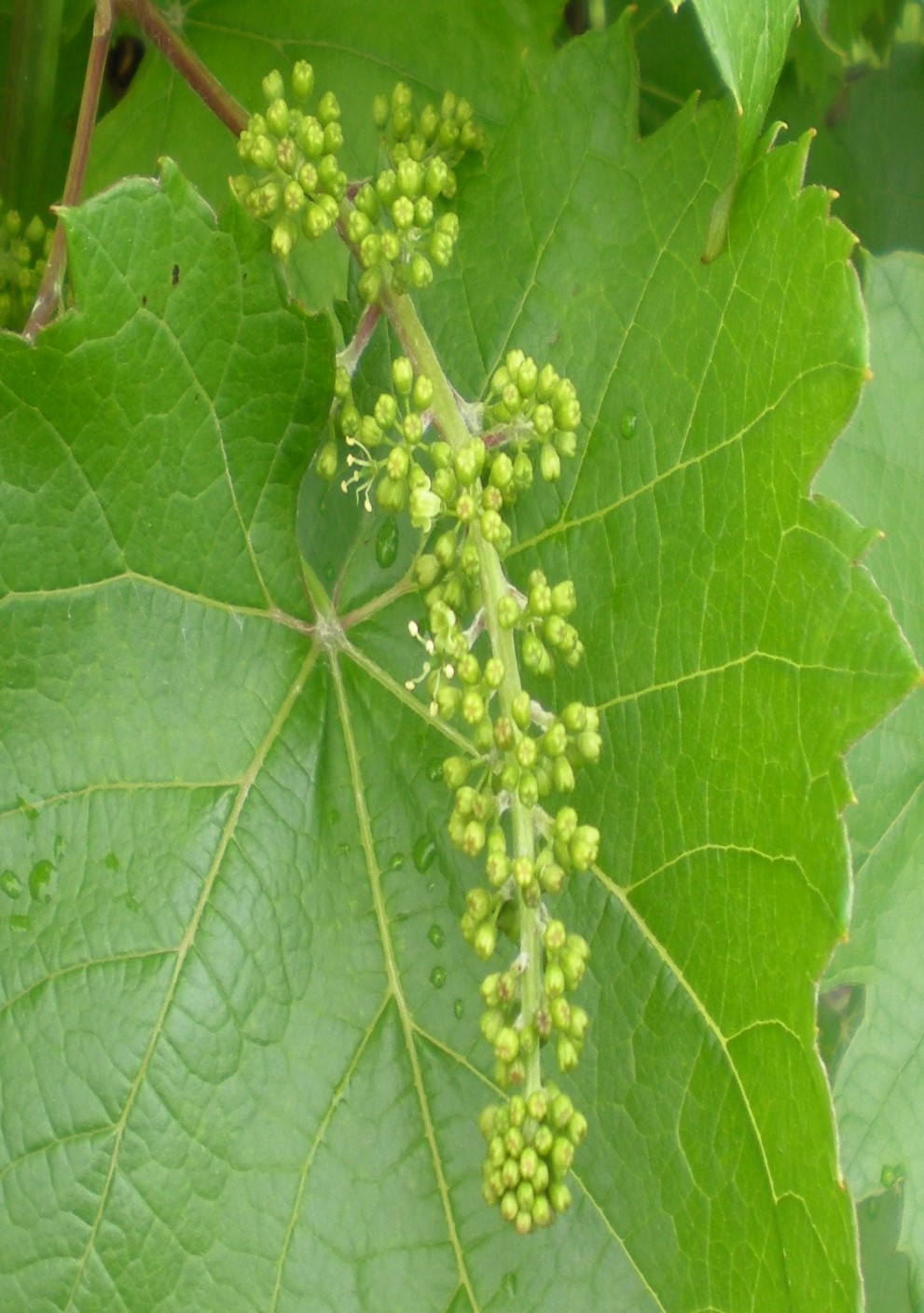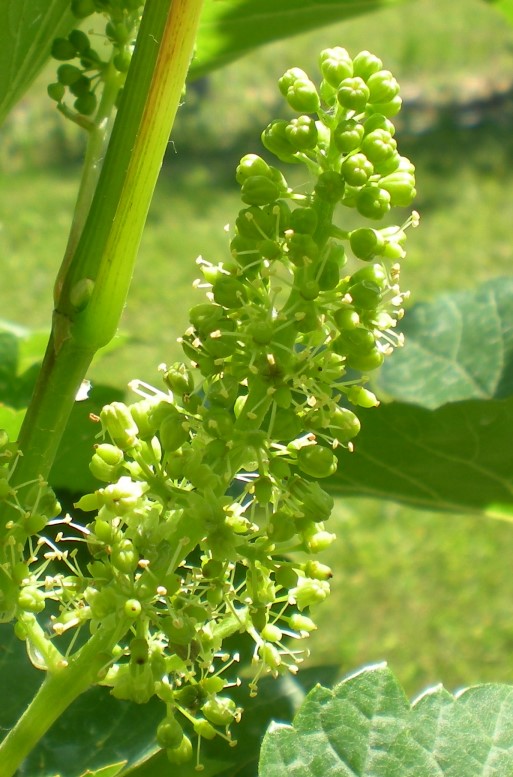Vinews
No. 9 — May 20, 2019
Contents:
- Immediate Pre-Bloom: Critical Period of Disease Management
- With Bloom Approaching, Remember Petiole Sampling
- Cumulative Growing Degree Days for the Seven Grape Growing Regions of Missouri from April 1 to to May 20, 2019
Immediate Pre-Bloom: Critical Period of Disease Management

The period from immediate pre-bloom through 5 weeks post bloom is the most critical time to protect your crop from pathogens. This period is when your crop is the most susceptible to fungal pathogens.
As the phenology of the vines progress from vegetative growth to reproductive growth, the potential for disease increases. Prior to pre-bloom disease management focused on keeping the shoots and leaves protected from disease. Depending on your vineyard location the inflorescence will soon begin flowering and this calls for increased vigilance to protect the crop from pathogens.
Right now we are entering the period where attention to detail will pay dividends at harvest. The immediate pre-bloom to 5 weeks post-bloom is when you should consider using your best disease management tools to control the grape disease complex.
Select fungicide products that will provide protection from phomopsis, black rot, downy mildew, powdery mildew, and anthracnose. These are the five major diseases of concern. Take some time now to plan for your next three cover sprays. This will help to avoid applying the same products repeatedly which can result in the selection for fungicide resistant pathogens. Depending on your past disease problems from last season as well as disease outbreaks that may have occurred this season consider using both systemic fungicides as well as protectant fungicides in a tank mix to protect your crop.
Phomopsis remains a threat, especially during the bloom period. During bloom Phomopsis spores can infect developing flowers. Phomopsis development remains dormant in developing berries until brix levels begin to rise starting at approximately 15 brix. Infected berries begin the rotting process and some infected berries shatter. The primary inoculum of Phomopsis is depleted shortly after bloom. Although grape berries are susceptible to Phomopsis throughout the growing season, reduced primary inoculum coupled with increasing temperature conditions reduce the threat of Phomopsis infections after the bloom period.
Use The Best Fungicides To Protect The Crop: Avoid Repeat Applications Of The Same Fungicide And Fungicides From The Same Chemical Class
During the critical period (pre-bloom to 5 weeks post bloom) fungicides from two chemical classes are often applied. Fungicides from these two classes provide good protection to a broad spectrum of pathogens. The two classes of fungicides are the strobilurins and the sterol-inhibitors. Both powdery mildew (Michigan)) and downy mildew (Virginia, North Carolina) have been identified that are resistant to these two classes of fungicides Therefore when planning your critical period spray program implement a spray program that avoids sequential applications of the same product or products within the same chemical class. Many of the labels of both strobilurins (Frac 11: Abound, Sovran, Flint) and sterol-inhibitors (Frac 3: Mettle, Procure, Rally or Tebuzol) limits the number of applications during the growing season. For example, the Rally label states that only two sequential applications of Rally or Rally and another product containing the same active ingredient as Rally or another Sterol inhibitor can be applied. Fungicides that contain more than one active ingredient (Pristine, Inspire Super, Revus Top, or Quadris Top) are also effective for broad spectrum disease management.
As the grape berries age they become resistant to some fungal diseases. Grape berries develop resistance to Black rot, downy mildew and powdery mildew approximately 3 to 5 weeks after bloom. Therefore early season disease management through post-bloom disease management are critical. Although berries develop resistance other green tissue remains susceptible throughout the growing season.
With Bloom Approaching, Remember Petiole Sampling

Grape growers that have vineyards just coming into fruit production often have questions about vineyard nutrient management. The questions often have to do with the when and why they should monitor the nutrient status of the vines. Tissue analyses or petiole sampling is normally undertaken for two reasons; routine nutrient status evaluation and to diagnose an observed suspected nutrient deficiency.
The routine assessment of the vines nutritional status should be done at a specific phenological stage. These phenological stages are full flowering and veraison. Full flowering can be defined as when 70% of the caps have been shed, whereas veraison is the onset of rapid fruit maturation, where visually a distinct color change is occurring. This color change is obviously more distinct in red varietals than white varietals. In white varietals, the color change often is from a dull green to a lighter transparent yellow.
The goal of routine nutrient assessment is to gauge the response of the vines to nutrient additions or determine the vine’s nutrient needs. The overall objective is to maintain the nutrient balance to produce high quality grapes by applying only nutrients that are needed, thereby saving money and also protecting the environment.
Petioles are collected from different locations on the shoot depending on the sampling period — full flowering or veraison. At full flowering you select leaves that are opposite of the flower clusters. Whereas at veraison, the 6th or 7th leaf from the shoot tip, which is the most recently fully expanded mature leaf is selected. Avoid collecting leaves from laterals. Once a leaf is collected, break the petiole (leaf stem) away from the leaf blade and discard the leaf blade. You will need to collect 60 to 100 petioles for a sample. These petioles should come from 25 to 50 different vines, but be of the same variety, rootstock, and soil type. If your vineyard has variable soil types, divide your vineyard into blocks and petiole sample each block.
In the case of trying to diagnose a suspected nutrient imbalance in a vine(s), you may only be able to select leaf samples from one or a few vines. Select leaves that are showing the suspected deficiency, but do not collect petioles from leaves that are insect, disease, or mechanically damaged. In addition to this sample, also collect petioles from the same variety that is not showing the deficiency. Send in both samples to be analyzed. You will then have results to compare from a healthy vine(s) and those vine(s) showing a deficiency.
Petioles should be stored in a paper bag to allow the petioles to dry. Petiole samples can be dropped off at University of Missouri County Extension Centers and will be analyzed by the University of Missouri Soil Testing and Plant Diagnostic Services.
Cumulative Growing Degree Days for the Seven Grape Growing Regions of Missouri from April 1 to May 20, 2019
| Region | Location by County | Growing Degree Days1 | ||
|---|---|---|---|---|
| 2019 | 2018 | 30-year Average | ||
| Augusta | St. Charles | 528 | 574 | 549 |
| Hermann | Gasconade | 534 | 548 | 541 |
| Ozark Highland | Phelps | 592 | 605 | 569 |
| Ozark Mountain | Lawrence | 578 | 619 | 567 |
| Southeast | Ste. Genevieve | 563 | 577 | 586 |
| Central |
Boone | 514 | 578 | 525 |
| Western | Ray | 468 | 556 | 504 |
1 Growing degree days at base 50 from April 1 to May 20, 2019. Data compiled from Useful and Useable at https://mygeohub.org/groups/u2u/tools. Click on link below to determine growing degree days in your area.
To determine the number of growing degree days accumulated in your area since April 1, use this tool.